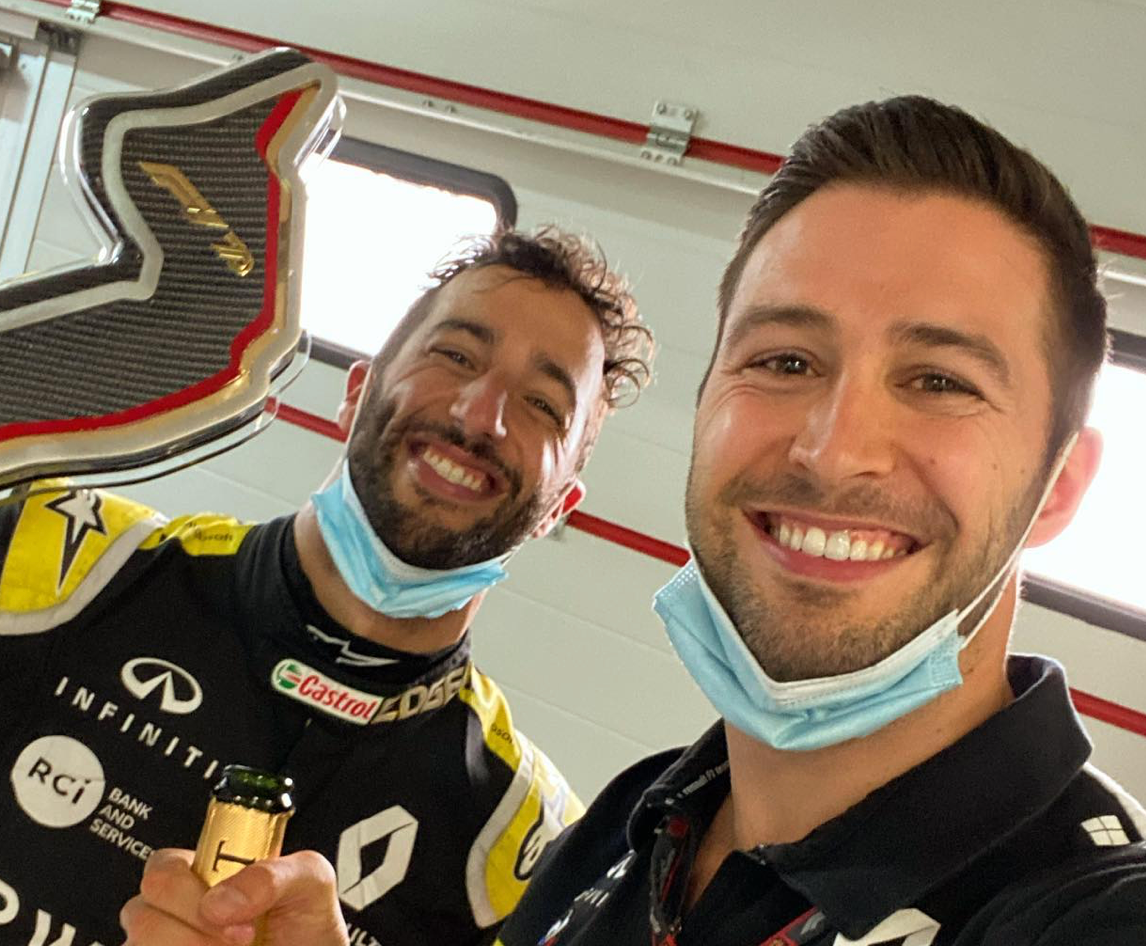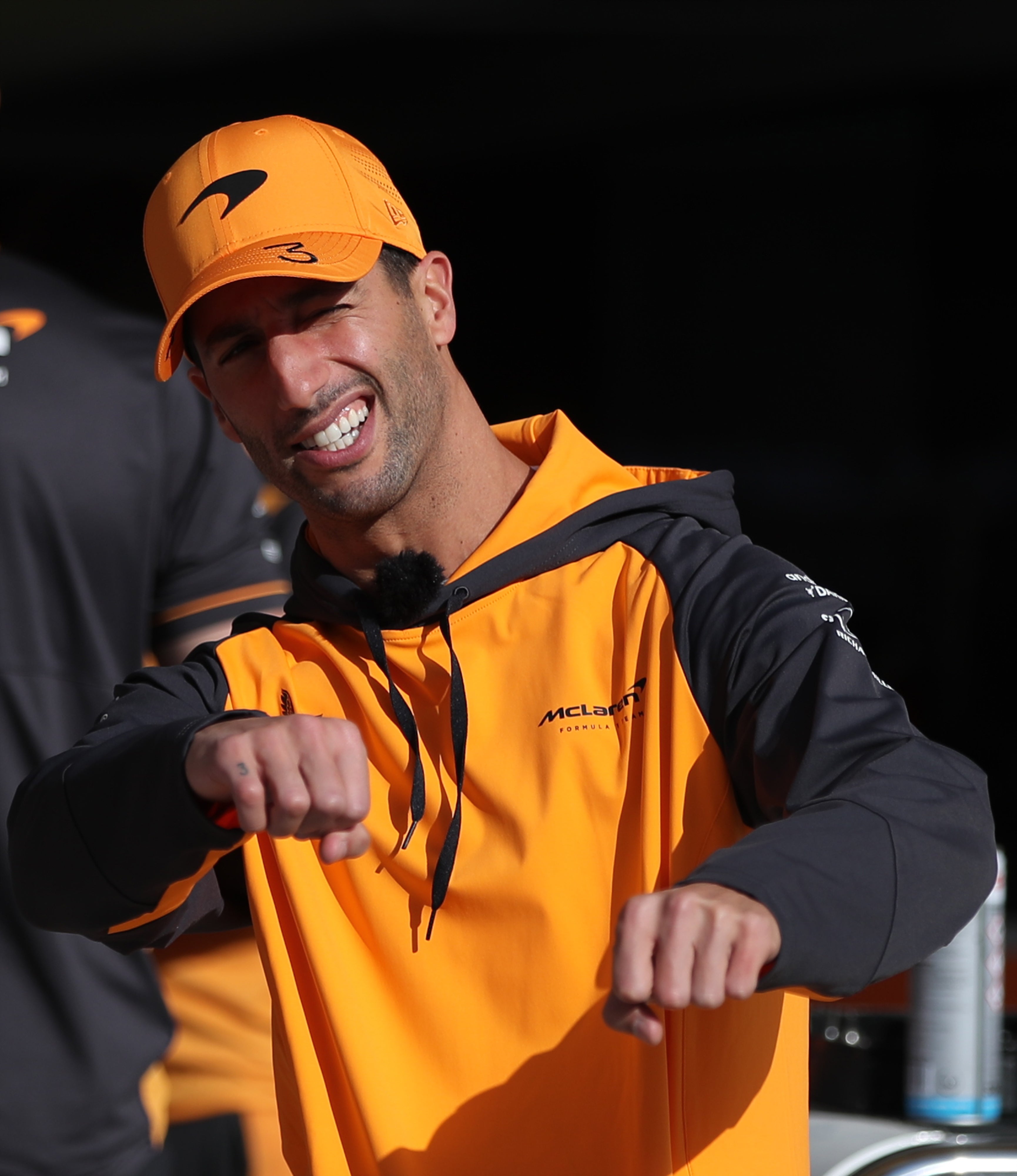Daniel Ricciardo’s trainer reveals how you finely tune a Formula One driver
Just as the cars have been prepped, checked and tweaked prior to the new Formula One season, the same goes for the men inside them

When Daniel Ricciardo wakes up in his hotel room in Bahrain on Sunday, ahead of the first Grand Prix of the 2022 Formula One season, he will do as we all do and check his phone. Glowing back at him will be a message from his long-time friend and trainer, Michael Italiano: “Start drinking!”
It will be the first of 22 such messages Italiano will send Ricciardo on the morning of races. From that point until he steps into the cockpit of his McLaren, the Australian driver will aim to consume three litres of water to accompany the regular meals of avocado on rye bread for breakfast, the chicken burrito for lunch and the snacks of biltong and popcorn. All the while providing updates on his hydration based on bathroom breaks: rating his urine of a scale of one (too clear) to five (too yellow) in search of an optimum of between one and two.
Perhaps the only point of difference to the preparation for Bahrain will be a visit to The Cheesecake Factory in the week – “He loves getting a few slices from there,” Italiano tells The Independent. Slices he’d have earned in moderation after three months of intense pre-season, it should be noted. Just as the machines have been prepped, checked and tweaked prior to the upcoming campaign, the same goes for the men inside them.
By now it is broadly understood that F1 drivers are some of the fittest athletes in the world. Italiano, who grew up in Perth and has been friends with Ricciardo since the age of 12, likens them to Aussie Rules footballers: “Those guys have to be strong, explosive and super fit. From a cardiovascular perspective it’s a little bit more elite because of the dynamic of the sport itself.”
That is reflected in the markers Italiano sets out for Ricciardo. By the time the season comes around, the 32-year-old has to be running 2km and 5km time trials under seven and 20 minutes respectively. Strength endurance is also quantified with maximums on push-ups, pull-ups, single-leg calf raises and planks.
Usually, Ricciardo’s conditioning begins in January. The month before is his own, urged by Italiano to delete his number before he gets back in touch for the business to start up once more. “We’re probably with each other 250 days of the year, probably more,” says Italiano. “It’s as much for him not to get sick of me, and vice versa.”
The Perth sun offers plenty of scope for rest and recuperation, and also the relentless grind when the new year ticks over. Gym work on the fundamentals involves plenty of core work and building up the posterior chain – calves, hamstrings, glutes and the lower back. “When you’re in an F1 car,” explains Italiano, “braking puts great strain on those areas. The hips, core and glutes also take continuous strain from just battling with the car, through the vibrations.”
Among the more traditional exercises is a regular in a driver’s routine that never ceases to confuse onlookers – the neck harness. This involves attaching a harness to the head and pulling it in four different directions for a certain amount of time, with the driver focused on keeping his head in the same neutral position. It looks like a form of medieval torture but is crucial to condition neck muscles to withstand the serious amounts of G-force felt in an F1 car. And with cars getting faster each year, those G-forces are only going up.
G-forces, as you might have known or guessed, relate to gravity. At any one time, the body experiences 1g of vertical G-force. The regular human body can withstand 100gs for a very short period of time. However you can blackout experiencing 4gs for a period of seconds. In a race, drivers experience an array of G-forces constantly over their two hours on the track and regularly contend with 6gs when cornering.
“You could probably debate boxers and rugby players in the scrum, and the NFL are in the realm, but an F1 driver’s neck strength is remarkable,” states Italiano.
Another aspect that needs to be addressed ahead of race season is the body’s capacity to regulate heat. “The ability to let the body cool is very difficult. He is in a cockpit, in a fire resistant suit, while trying to perform for two hours straight without a break; you need to be fit, strong. Don’t forget the engine’s right behind you, too. What happens is you start perspiring more and start fatiguing and your reactions taper off. That’s when you can start losing one- or two-tenths [of a second] per lap. That is where they are set apart: consistent lap times, not making a mistake. I think it’s so underrated as a skill.”
Perhaps the most impressive aspect to all this is that Ricciardo has maintained the necessary levels despite the challenges of the last two years. This year the month break was just two weeks because of the late finish of the 2021 schedule. Last season’s preparations were hampered by Italiano getting stuck in London lockdown while Ricciardo was in Los Angeles.
To get around that, Italiano designed an app – MI Coaching – to train Ricciardo and other clients, while also keeping tabs on their nutrition.
“Looking back, we had to adapt to the situation, but the online stuff actually works if you both put the effort in.” It was one of a few short-term adjustments for the pandemic that will have longer-term use.
“Half my suitcase now is full of mobile equipment,” says Italiano. “Resistance bands, sliders, skipping rope. Just being a little bit more versatile with our training methods. A lot of the times we’d get to hotels, the gyms were closed because of Covid. So we didn’t have facilities to train out of.
“You’re also reaching out to technology a bit more: a Hypervolt gun for a massage because you couldn’t get a masseuse because of Covid. An Oura ring to measure his sleep. We’re still using all that now and probably still will when the world gets back to some form of normality.”
When the lights go green in Bahrain on Sunday (6pm local time, 3pm GMT), the bulk of Italiano’s work will have been done. After a tough few season of soul-searching, all eyes will be on Ricciardo behind the wheel to see if someone widely regarded as more of the most naturally talented drivers on the circuit can dramatically improve on last season’s eighth-place finish in the driver’s standings.
There will still be ticking over for Italiano, especially around recovery given how condensed this season is, and the issues around jet lag that need to be managed on a weekly basis. A refresher on fitness will come in the August break. But by and large, professional duties will be replaced in part by a more personal tact.
Italiano has sourced a mini-basketball hoop to take on tour to offer an extra distraction. He will also be an accomplice for Ricciardo at the various exotic locations they travel, imploring him to get the bottle of red from the Napa Valley he is always drawn to on a wine list, or the “spicy margarita” he’s partial to. There is also the stern “24-hour rule” that remains in place, whereby Ricciardo can vent on anything and everything he wants after a race for that period before switching focus to the positive opportunities of the next one.

“It’s the finer things of life you have to enjoy,” effuses Italiano. “There are obviously times to be serious but if you’re too one-way, that can be more detrimental. There’s no need to be too hard on himself, too serious.
“Sport can be an emotional rollercoaster, but F1 in particular because there can be so many contingencies out of your control. Your engine can go, you can get hit in turn one, you can get a puncture. There are so many things out of your control to frustrate your weekend even if you are feeling good.”
No doubt this balance was the hardest to strike. Ricciardo is operating at the pointy end of professional sport, where the margins are slim and reaction times short. And with Italiano’s help, the pair are unequivocal in their belief that the best times lie ahead.
“The car was very good last year and if McLaren continue with that trajectory I do see more success to him. There’s certainly no reason he can’t from a physical and talent perspective, there are another five years if he really wants it.”
Few are better placed than Italiano to make that assertion.
Michael Italiano is the founder of MI Coaching, the online coaching platform giving you access to elite level performance training. To learn more, click here
Join our commenting forum
Join thought-provoking conversations, follow other Independent readers and see their replies
Comments
Bookmark popover
Removed from bookmarks